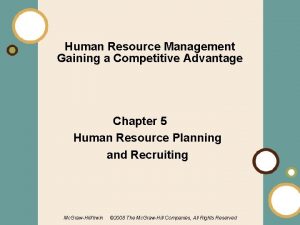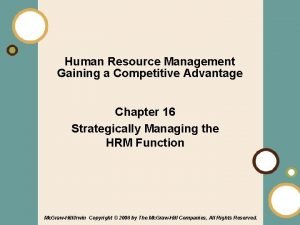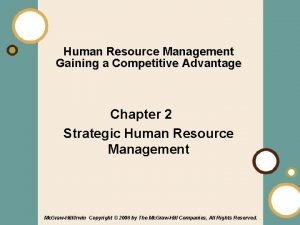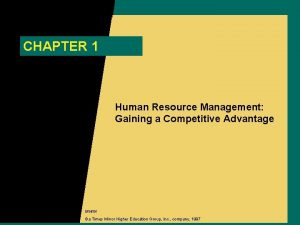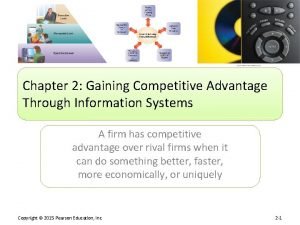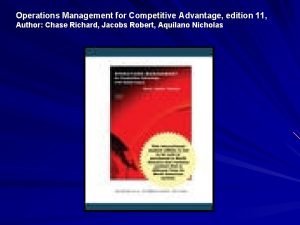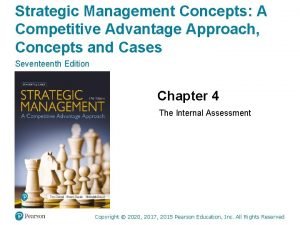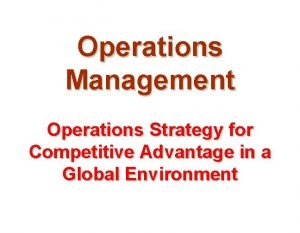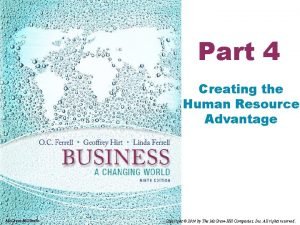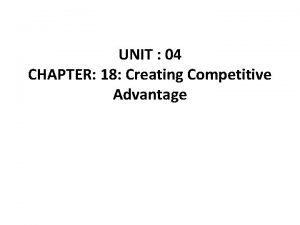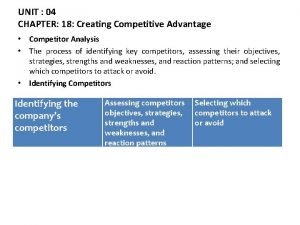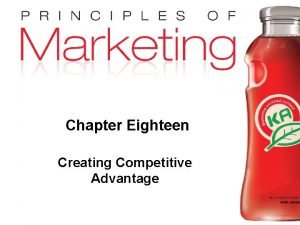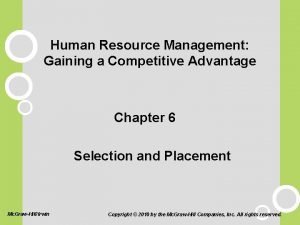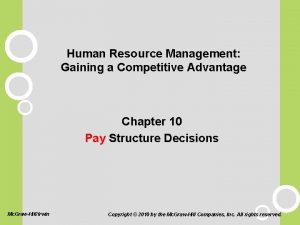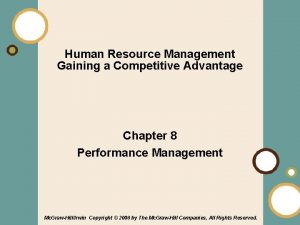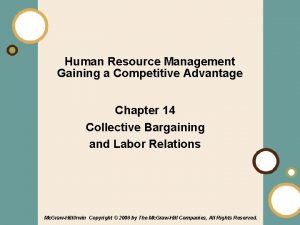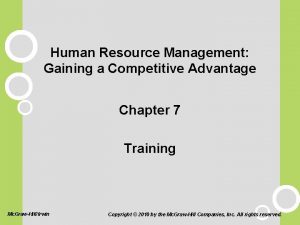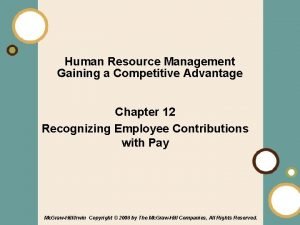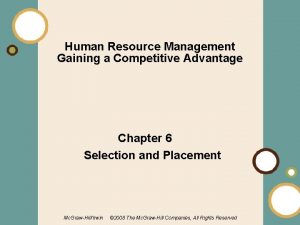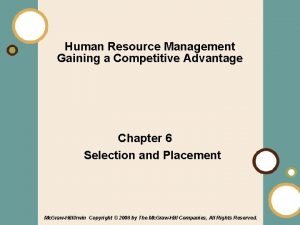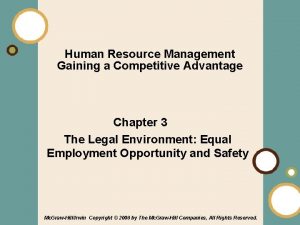Human Resource Management Gaining a Competitive Advantage Chapter















- Slides: 15

Human Resource Management Gaining a Competitive Advantage Chapter 13 Employee Benefits Mc. Graw-Hill/Irwin Copyright © 2008 by The Mc. Graw-Hill Companies, All Rights Reserved. 1 -1

Reasons for Benefits Growth • Laws mandating benefits passed during and after the Great Depression • Wage and price controls instituted during WWII and labor shortages • The tax treatment of benefits programs • Large group v. individual insurance • Organized labor • Employer differentiation 13 -2

Social Security • Social Security includes provision for old-age insurance, unemployment insurance, survivors' insurance, disability insurance, hospital insurance, and supplementary medical insurance. • Social Security retirement benefits are free from federal tax and free from state tax in some states. • Currently, full benefits begin at age 65 or a reduced benefit can begin at age 62. • Both employers and employees are assessed a payroll tax. 13 -3

Unemployment Insurance • Unemployment insurance has the following objectives: – to offset lost income during involuntary unemployment, – to help unemployed workers find new jobs, – to provide an incentive for employers to stabilize employment, – to preserve investments in worker skills by providing workers with income during short-term layoffs. • Unemployed workers are eligible for benefits if they – have a prior attachment to the workforce, – are available for work, – are actively seeking work, – were not discharged for cause, did not quit voluntarily, and are not out of work because of a labor dispute. 13 -4

Workers’ Compensation • Workers' compensation laws cover jobrelated injuries and death. • The system is based on no-fault liability. • Approximately 90 percent of U. S. workers are covered. 13 -5

Private Group Insurance • Medical insurance tends to be the most important benefit for people. – The Consolidated Omnibus Budget Reconciliation Act (COBRA) requires employers to permit employees to extend their health insurance coverage at group rates for up to 36 months following a qualifying event, such as termination. 13 -6

Retirement Defined Benefit Plan • Guarantees a specified retirement benefit level to employees. • Insulates employees from investment risk, which is borne by the company. • PBGC guarantees basic retirement benefit in case of financial difficulties. • ERISA increased the fiduciary responsibilities of pension plan trustees, established vesting rights and portability provisions, and established the PBGC. Defined Contribution Plan • Does not promise employees a specific benefit level upon retirement. • Employers shift investment risk to the employee. • There is no need to calculate payments based on age and service. • Most prevalent in small companies. 13 -7

Cash Balance Plans • An employer sets up an individual account for each employee and contributes a percentage of the employee’s salary. • The account earns interest at a predefined rate. 13 -8

Funding, Communication, and Vesting Requirements • ERISA guarantees that employees, after working a certain number of years, earn the right to a pension upon retirement. – These are referred to as vesting rights. • Vesting schedules that may be used are as follows: – Employees are vested after five years of service. – Employers may vest employees over a three- to seven-year period, with at least 20 percent in the third year and each year thereafter. 13 -9

Family-Friendly Policies • To ease employees’ conflicts between work and nonwork, organizations may use family-friendly policies such as family leave policies and child care. • The Family and Medical Leave Act: – applies to organizations with 50 or more employees within a 75 -mile radius – applies to childbirth or adoption; care for a seriously ill child, spouse, or parent; or for an employee's own serious illness. – Employees are guaranteed the same or comparable job when they return to work. – Employees with less than a year of service or those who work less than 25 hours a week are not covered. 13 -10

Healthcare: Controlling Costs and Improving Quality • In the United States, health-care expenditures have gone from 5. 3 percent of the GNP in 1960 to 14 percent recently. • Attempts at cost control have come through employers, since most health care is provided through organizations. • A recent trend has been to shift costs to employees through the use of deductibles, coinsurance, exclusions and limitations, and maximum benefits. 13 -11

Healthcare: Controlling Costs and Improving Quality Health maintenance organizations (HMO) • focus on preventive care and outpatient treatment. • require employees to use only HMO services and providing benefits on a prepaid basis. • physicians and health-care workers paid a flat salary to reduce incentive of raising costs. Preferred provider organizations (PPOs) • have contract with employers and insurance companies, to provide care at reduced fees. • do not provide benefits on a prepaid basis. • employees often are not required to use just the PPOs. • tend to be less expensive than traditional health care but more expensive than HMOs. 13 -12

Flexible Benefit Plans • These plans permit employees to choose the types and amount of benefits that they want. • Advantages include: – employees can be more aware and appreciative of their benefits package – a better match between the package and the employee's needs, which improves satisfaction and retention – cost reductions are often achieved • Disadvantages include: – high administrative cost – adverse selection 13 -13

Flexible Spending Accounts • Permits pretax contributions to an employee account that can be drawn on to pay for uncovered health care expenses. • Funds must be spent during the year or they revert to the employer. • The major advantage is that take-home pay increases. 13 -14

General Regulatory Issues • Benefit plans must meet nondiscrimination rules and qualified plans. • Sex, age, and disability: – It is illegal for companies to require that women contribute more to a pension plan than men. – Employers cannot discriminate against employees over the age of 40 in terms of pay or benefits. – employees with disabilities have equal access to the same health insurance coverage as other employees. • Monitoring Future Benefits Obligations - The Financial Accounting Statement (FAS) 106 states that any benefits (excluding pensions) provided after retirement, cannot be funded on a pay-as-you-go basis. – They must be paid on an accrual basis. 13 -15
 Human resource management gaining a competitive advantage
Human resource management gaining a competitive advantage Human resource management gaining a competitive advantage
Human resource management gaining a competitive advantage Human resource management gaining a competitive advantage
Human resource management gaining a competitive advantage Human resource management gaining a competitive advantage
Human resource management gaining a competitive advantage Human resource management: gaining a competitive advantage
Human resource management: gaining a competitive advantage Human resource management gaining a competitive advantage
Human resource management gaining a competitive advantage Gaining competitive advantage through information systems
Gaining competitive advantage through information systems Competitive dynamics examples
Competitive dynamics examples Operations management for competitive advantage
Operations management for competitive advantage Strategic management a competitive advantage approach
Strategic management a competitive advantage approach Operations management for competitive advantage
Operations management for competitive advantage Human resource advantage
Human resource advantage Chapter 18 creating competitive advantage
Chapter 18 creating competitive advantage Competitor centered company
Competitor centered company Chapter 2 strategic planning for competitive advantage
Chapter 2 strategic planning for competitive advantage Chapter 18 creating competitive advantage
Chapter 18 creating competitive advantage

